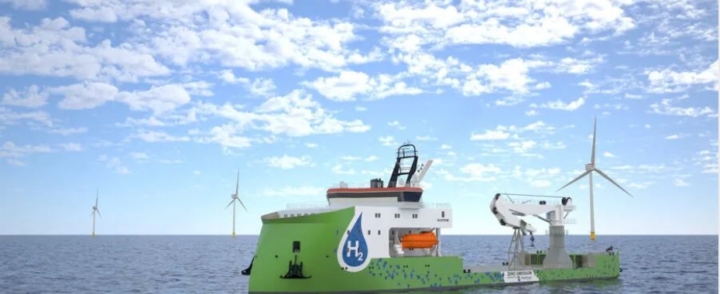Green, hydrogen-powered offshore construction support vessel
The ULSTEIN SX190 Zero Emission DP2 construction support vessel is designed for marine operations of today and tomorrow. Running on hydrogen, it can shrink the environmental footprint of offshore renewables.
While wind is a clean energy source, the construction and service vessels used for offshore wind farms generally still run on fossil fuels.
To meet growing demand for zero-emission operations as well as the International Maritime Organization’s (IMO) target of halving maritime transport emissions by 2050, new vessels that run on alternative fuels are needed.
Hydrogen is one of the most promising alternative fuels for offshore vessels, and is completely zero-emission when produced with renewable energy or from natural gas with carbon capture. However, use of hydrogen as fuel currently faces several challenges, such as fuel storage and, in particular, a lack of bunkering infrastructure in ports. This is a classic chicken-and-egg dilemma.
Hydrogen-powered hybrid vessel for offshore wind farms
The ULSTEIN SX190 Zero Emission DP2 construction support vessel is a key step towards zero-emission offshore vessels and marks the start of Ulstein’s roadmap to a hydrogen future.Designed using proven and readily available technology, the vessel can already operate in DP mode for up to five days using hydrogen fuel. For prolonged operations, the vessel can be powered by a more conventional diesel-electric system using low sulphur fuel oil. The hydrogen fuel cells are located in a separate, second engine room. To keep the vessel independent of hydrogen bunkering facilities, hydrogen storage containers are located on the aft deck. The hydrogen gas can be refilled by trucks at the quayside, or the storage containers can be lifted off the vessel and transported to an inland hydrogen plant for bunkering.
Concrete benefits
Due to the current lack of hydrogen bunkering facilities, the ULSTEIN SX190 Zero Emission vessel does not have large hydrogen storage tanks.
When hydrogen bunkering infrastructure becomes available in ports, the vessel can be retrofitted, without major modification or expense, with two large, below-deck liquid hydrogen storage tanks. This will extend the hydrogen fuel range to a full month. After retrofitting, the on-deck hydrogen storage containers will be removed, freeing the deck for commercial use.
The ULSTEIN SX190 Zero Emission vessel demonstrates that an offshore vessel can already be operated in zero emission mode using current, off-the-shelf technology. It also enables shipowners to become early adopters by investing in a ship that can easily be adapted to future hydrogen developments.


